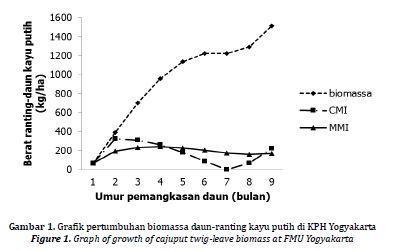Daur Optimum Pemangkasan Daun Kayu Putih di KPH Yogyakarta

Downloads
The productivity of cajuput plantation has improved through tree breeding, while manipulation of site and management engineering of timber plantations have been less attention. Management engineering can be obtained by determining the optimum cycle of cajuput leaves harvesting. This study aims to determine the optimum cycling of cajuput leaves harvesting at KPH Yogyakarta by considering the biological cycles of cajuput leaves, chemical physical properties, and the yield of cajuput oil. The tools used in the research were digital scales, distillation devices, and testing tools of physical-chemical properties of cajuput oil. The material for research wasthe cajuput plantsat KPH Yogyakarta. Data of cajuput leave-twig biomass were obtained for 9 months from 9 plots which were well distributed on various ages. Biological cycle analysis uses curent monthly increment (CMI) and mean monthly increment (MMI) intersection approach. Analysis of the physical-chemical properties on cajuput oil refers to SNI 3954:2014 on cajuput oil. The results showed that the biological cycles of cajuput leaves were obtained 5 months after leaves harvesting. The chemical physical properties of cajuput oil that meet the requirements of SNI were achieved after the leaves are 7 months after harvested. The yield of cajuput oil which isabove 0.7% was obtained after the leaves are 8 months after harvested. Thus, the optimum cycle for harvestingof cajuput leaves in KPH Yogyakarta is after 8 months.
Badan StandarisasiNasional. (2014). SNI 3954:2014 Minyak Kayu Putih. Jakarta.
Baskorowati, L., Susanto, M., Prastyono, Kartikawati, N., & Rimbawanto, A. (2012). Variation of seed production and viability in a full-sib trial of Melaleuca cajuputisub sp. cajuputi inGunungkidul Yogyakarta. Journal of Forestry Research, 9(2), 73–80.
Budiadi, Kanazawa, Y., Ishii, H. T., Sabarnurdin, M. S., & Suryanto, P. (2005a). Productivity of kayu putih (Melaleuca leucadendronLINN) tree plantation managed in non-timber forest production systems in Java, Indonesia. Agroforestry Systems, 64(2), 143–155. https://doi.org/10.1007/s10457-004-0777-6
Budiadi, Ishii, H. T., Sunarta, S., & Kanazawa, Y. (2005b). Variationin Kayu Putih (Melaleuca leucadendronLINN) Oil Quality under Different Farming Systems in Java, Indonesia. Eurasian Journal of Forest Research, 8(1), 15–20.
Claudio, L., Barbosa, A., Silva, C. J., Teixeira, R. R., Maria, R., & Alves, S. (2013). Chemistry and Biological Activities of Essential Oils from Melaleuca L . Species. Agriculturae Conspectus Scientificus, 78(1), 11–23.
Dinas Kehutanandan Perkebunan DIY. (2014). Rencana Pengelolan Hutan Jangka Panjang Kesatuan Pengelolaan Hutan (RPHJP KPHP) Model Yogyakarta Daerah Istimewa Yogyakarta. Yogyakarta: Dinas Kehutanan dan Perkebunan DIY.
Fall, R., Ngom, S., Sall, D., Sembène, M., & Samb, A. (2017). Chemical characterization of essential oil fromthe leaves of Callistemon viminalis(D.R.) and Melaleuca leucadendron(Linn.). Asian Pacific Journal of Tropical Biomedicine, 7(4), 347–351. https://doi.org/10.1016/j.apjtb.2017.01.004
Indrajaya, Y. (2017). Daur Optimal Hutan Tanaman SengonDalam Proyek Aforestasi: Review Hasil Penelitian Suharlan 1975. Jurnal Penelitian Kehutanan Wallacea, 6(2), 147-156.
Indrajaya, Y., & Siarudin, M. (2015). Pengaturan Hasil AgroforestryJabon (Neolamarckia cadamba) Dan Kapulaga (Amomum compactum) Di Kecamatan Pakenjeng, Garut, Jawa Barat. Jurnal Penelitian Sosial dan Ekonomi Kehutanan, 12(2), 121-130.
Kartikawati, N. K. (2015). Indeks overlap dan sinkronisasipembungaan dalam kebun benih kayuputih (Melaleuca cajuputi) di Paliyan, Gunungkidul, 103–116.
Kartikawati, N. K. (2016). Fertility Variation Of Melaleuca cajuputisubsp . cajuputi And Its Implication In Seed Orchard Management, 3(2), 83–94.
Kartikawati, N. K., Prastyono, & Rimbawanto, A. (2016). PeningkatanGenetika Aktual Dan Interaksi Sumber Benih X Lokasi Terhadap Kadar 1,8 Cineole Dan Rendemen Minyak Pada Kayu Putih, 10(2), 123–134.
Kartikawati, N. K., Rimbawanto, A., Susanto, M., Baskorowati, L., & Prastyono. (2014). Budidaya Dan Prospek Pengembangan Kayu Putih (Melaleuca cajuputi).Bogor:IPB Press.
Khabibi, J. (2011). Pengaruh Penyimpanan Daun Dan VolumeAir Penyulingan Terhadap Rendemen Dan Mutu Minyak Kayu Putih(skripsi). Bogor: Institut Pertanian Bogor.
Mulyana, B., Rohman, & Wardhana, W. (2018). Luas Optimum Petak Ukur Untuk Hutan Tanaman Kayu Putih Di Kesatuan Pengelolaan Hutan Yogyakarta. Jurnal Faloak, 2(1), 29–38.
Murtagh, G. (1996). Month of Harvest And Yield Components Of Tea Tree Biomass. Australian Journal of Agricultural Research, 47(5), 801–815.
Muyassaroh. (2016). Distilasi Daun Kayu Putih Dengan Variasi Tekanan Operasi Dan Kekeringan Bahan Untuk Mengoptimalkan Kadar Sineol Dalam Minyak Kayu Putih. Jurnal Teknik Kimia, 10(2), 36–39.
Padalia, R. C., Verma, R. S., Chauhan, A., Goswami, P., Verma, S. K., & Darokar, M. P. (2015). Chemical composition of Melaleuca linarrifoliaSm. from India: A potential source of 1,8-cineole. Industrial Crops and Products, 63, 264–268. https://doi.org/10.1016/j.indcrop.2014.09.039
Pujiarti, R., Ohtani, Y., & Ichiura, H. (2011). Physicochemical properties and chemical compositions of Melaleuca leucadendronleaf oils taken from the plantations in Java, Indonesia. Journal of Wood Science, 57(5), 446–451.https://doi.org/10.1007/s10086-011-1183-0
Rahmawati, A., Alberto, E., & Soemarno. (2016). Pengaruh kompos limbah daun minyak kayu putih untuk pertumbuhan semai tanaman kayu putih. Jurnal Tanah Dan Sumberdaya Lahan, 3(1), 293–301.
Siahaya, T. E., Siahaya, J., & Wagiman, S. (2006). Pengaruh Kelerengan, Pemeliharaan Tanaman Dan Lama Penyimpanan Daun Terhadap Rendemen Dan Mutu Minyak Kayu Putih (Melaleuca leucadendronLINN.). Jurnal Kehutanan Unmul, 2(1), 100–113.
Siarudin, M., & Widiyanto, A. (2014). Karakteristik Penguapan Air Dan Kualitas Minyak Pada Daun Kayu Putih Jenis Asteromyrtus symphyocarpa. Jurnal Penelitian Hasil Hutan, 32(2), 139–150.
Silva, C. J., Barbosa, L. C. A., Demuner, A. J., Montanari, R. M., Pinheiro, A. L., Dias, I., & Andrade, N. J. (2010). Chemical composition and antibacterial activities from the essential oils of myrtaceae species planted IN Brazil. Quimica Nova, 33(1), 104–108. https://doi.org/10.1590/S0100-40422010000100019
Susanto, M., Doran, J., Arnold, R., & Rimbawanto, A. (2003).Genetic variation in growth and oil characteristics of Melaleuca cajuputisubsp. Cajuputi and potential for genetic improvement. Journal of Tropical Forest Science, 15(3), 469–482.
Utomo, P. M. (2012). Model Produksi Daun Pada Hutan Tanaman Kayu Putih (Melaleuca cajuputisubsp cajuputi Powell)(Disertasi).Bogor:Institut Pertanian Bogor.
Utomo, P. M., Suhendang, E., Syafii, W., & Simangunsong, B. C. (2012). Model produksi daun pada hutan tanaman kayu putih (Melaleuca cajuputiSubsp cajuputi. Powell) sistem pemanenan pangkas tunas. Jurnal Hutan Tanaman, 9(4), 195–208.
Widiyanto, A., & Siarudin, M. (2013). Karakteristik Daun dan Rendemen Minyak Atsiri Lima Jenis Tumbuhan Kayu Putih. Jurnal Penelitian

